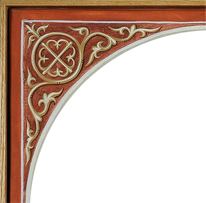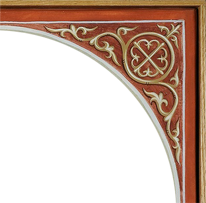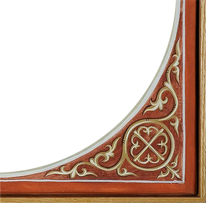Among the church services held during Lent, the Liturgy of the Presanctified Gifts, performed on Wednesdays and Fridays, holds an important place. During this service the Holy Gifts, blessed during the previous Sunday's Liturgy are saved in the artophorion (gold plated vessel on the Holy Table). On Sunday, there are additional lambs (prosphoras) prepared and consecrated along with the lamb used for communion on Sunday. Just after the elevation of the Gifts (“Holy Things are for the holy”), the additional lambs are intincted (infused) with the Holy Blood from the Chalice. These infused Lambs are then set aside in the artophorion. At the Presanctified Divine Liturgy, these consecrated Gifts are brought out and offered for communion to believers. The origin of the Liturgy of the Presanctified Gifts goes back to the first centuries of Christianity. During the constant persecutions by the pagans, the Christians wished to receive the Body and Blood of Christ as often as possible. However, the fulfillment of the Liturgy as a service of thanksgiving does not conform to the fast and the grief over sins during Lent. Therefore, the normal Liturgy was replaced during week days by the service of the Presanctified Gifts during which one can receive sacraments blessed earlier.
The Liturgy of the Presanctified Gifts in those ancient times was performed in the evening, which explains why vespers were included with it. The service that we currently use for the Liturgy of the Presanctified Gifts is attributed to the work of Saint Gregory Dialogos, Bishop of Rome (604 AD).
The order of the Liturgy of the Presanctified Gifts is as follows. After the intonement of the priest "Blessed is the Kingdom," the 103rd Psalm "Bless the Lord, O my soul" is read. The Great Litany is then intoned and the 18th Kathisma (Psalms 119–133) is read. During this time, in the altar, the priest transfers the presanctified gifts from the Holy Table, where they are kept in the artophorion, to the table of oblation. This is done in three stages (coordinated with each of the three antiphons of the 18th Kathisma). During the first section, the curtain is closed and the priest opens the antimins on the Holy Table. On the antimins he places an empty paten (the plate that is used for the lamb – the bread for communion). He also brings out the container with the presanctified gifts and carefully transfers the presanctified gifts from the container onto the paten. The clergy then make a prostration and the curtain is opened again.
After the little litany, during the second antiphon, the clergy cense around the Holy Table with the Gifts three times. Again there is a little litany and with the beginning of the third antiphon, the curtain is again closed. The clergy take up the paten with the Gifts and transfer it to the table of Oblation. The priest carries the gifts “upon his head” (raised up to about eye level) and the deacon walks in front of him, censing the gifts as they proceed from one place to the other. Once the Gifts are placed on the table of Oblation, the chalice is filled with wine and the chalice and paten are covered with the aers. The priest then censes the Gifts and makes a prostration. He returns to the Holy Table, closes the antimins and opens the curtain.
Then the choir sings "Lord I have called unto Thee" with stichiras. The priest makes an entrance with the censor. The choir sings "O Joyful Light," and the first Paremiae (a selection from the Bible, in this case the book of Genesis) is read. After this reading, the priest lifts up a candle and the censor and proclaims "Wisdom, let us attend. The Light of Christ illumines all men," At this time all those praying in the Church will prostrate themselves. The second Paremiae (a selection from the book of Proverbs) is then read.
When the readings are finished, the choir (or a trio selected from the choir) sings a spiritually moving prayer "Let my prayer be directed as incense before Thee." During the verses of this hymn we all prostrate ourselves, however, in many parishes (and this is the case in our own parish) the people all stand and sing each refrain in response to the verses. After the hymn, the prayer of St. Ephraim is read.
After the triple litany, the litany for the catechumens and the litanies of the faithful, the choir sings "Now the powers of Heaven with us invisibly do worship," and the Great Entrance with the Presanctified Gifts takes place. This entrance is made in silence and everyone in the Church prostrates during the entire time of the entrance. The prayer of St. Ephraim the Syrian is repeated. After this, the Royal Doors are closed and the curtain is drawn halfway. The Litany before the Lord’s prayer proclaimed. The Lord's prayer is chanted while all present prostrate themselves. From his place before the Holy Table, the priest touches the Presanctified Gifts and proclaims: "The Presanctified Holy Things are for the holy." At this time, the curtain is fully closed while the clergy commune and the Gifts are prepared for distribution. The Holy Sacraments are brought out through the Royal Gates, and the believers receive Holy Communion. After the Litany of Thanksgiving and the prayer before the Ambo, the believers venerate the Holy Cross and hear the prayers of Thanksgiving for Holy Communion read from the kliros.
This beautiful service can only be experienced during the weekdays of Great Lent. It is a very humbling and awe inspiring service that is in many ways different from the normal Sunday Liturgy. Where the Sunday Liturgy is filled with the joy of the Resurrection (for each Sunday is a “Little Pascha”) the presanctified Liturgy is repentant in tone, encouraging us to leave behind our sins and to follow Christ. All Orthodox Christians should take advantage of this opportunity to receive the Mysteries more frequently during Great Lent.



